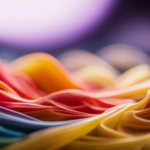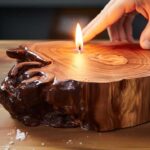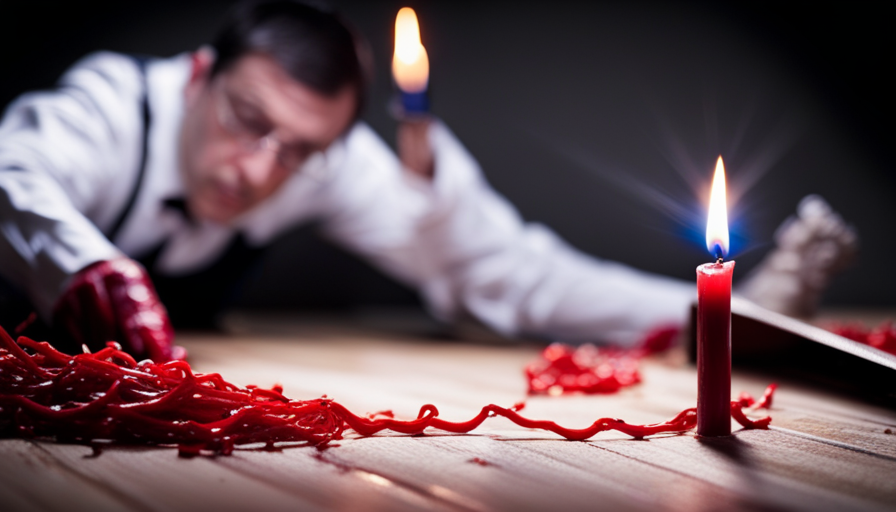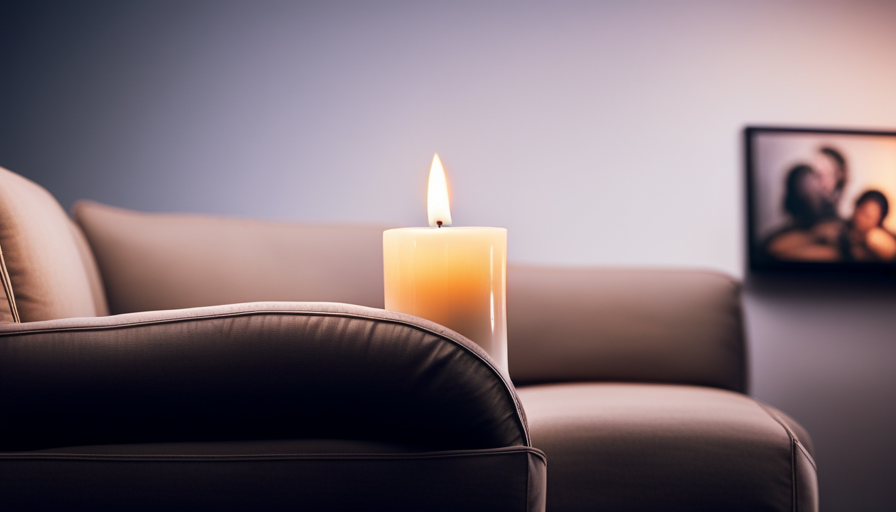As I gaze at the flickering glow of a candle, I am reminded of the enchanting dance of brightness and warmth it brings to a space. Even as the candle shrinks, it leaves a small pool of wax that may seem insignificant. But do not fret, for this melted residue holds endless possibilities!
In this article, I will guide you through the myriad of ways to transform that extra candle wax into something extraordinary. From creating new candles and delightful wax melts to crafting DIY fire starters and enchanting wax seal letters, the options are as vast as the imagination.
Engage your little ones with wondrous wax crafts, or utilize wax for furniture and wood care, rust prevention, and even beauty and self-care. With a little knowledge and a touch of creativity, that leftover wax will no longer go to waste.
So, join me on this journey of discovery as we unlock the hidden potential of candle wax, turning remnants into works of art and practical wonders. Let’s embark on this wax-filled adventure together!
Key Takeaways
- Candle wax can be repurposed into new candles, wax melts, DIY fire starters, and wax seal letters.
- Wax melts are a flameless alternative to candles and can be made using leftover candle wax.
- DIY fire starters can be made using candle wax, cardboard egg cartons, and dryer lint.
- Wax seal stamps can be used to create unique designs and explore different colors.
Make New Candles
If you’re feeling crafty, you can repurpose that extra candle wax and transform it into beautiful new candles. Candle making techniques are easy to learn, and you’ll be amazed at the results you can achieve by repurposing old candles.
To start, gather your leftover wax and remove any wicks or debris. If the wax has hardened, simply heat it in a double boiler until it becomes liquid again.
Next, choose a container for your new candle. It could be a glass jar, a tin can, or even a teacup. Place a wick in the center of the container and secure it with a dab of hot glue.
Slowly pour the melted wax into the container, making sure to leave enough space at the top for the wax to expand when it solidifies. Let the candle cool and harden overnight.
The next day, trim the wick to a quarter of an inch and light up your beautiful new candle.
Now, onto the next section about creating wax melts, a great alternative to candles.
Create Wax Melts
To get creative and make your space smell amazing, consider crafting your own wax melts using leftover candle wax. Wax melts are a fantastic alternative to traditional candles because they provide a flameless way to enjoy beautiful scents throughout your home. Not only are they easy to make, but they also offer several benefits.
Here are four wax melt recipes you can try:
-
Lavender Dreams: Mix lavender essential oil with dried lavender buds for a calming and soothing scent.
-
Citrus Burst: Combine orange, lemon, and grapefruit essential oils for a refreshing and uplifting aroma.
-
Cozy Vanilla: Blend vanilla extract and cinnamon oil for a warm and inviting fragrance.
-
Fresh Linen: Use a combination of clean cotton and fresh linen scents for a crisp and revitalizing smell.
Using wax melts has several advantages. They last longer than traditional candles, as the scent is released slowly over time. Additionally, they’re safer to use since there’s no open flame. Wax melts are also versatile, as you can mix and match scents to create your own unique combinations.
Now, let’s transition to the next section about DIY fire starters.
DIY Fire Starters
Get creative and ignite your fire easily with DIY fire starters that you can easily make at home! When it comes to repurposing candle wax, making fire starters is a great option. Not only does it save you money, but it also helps reduce waste.
DIY fire starters are simple to make and can be used for camping trips, bonfires, or even just starting a cozy fire in your fireplace. To make DIY fire starters, you’ll need some candle wax, cardboard egg cartons, dryer lint, and a double boiler.
Start by melting the candle wax in the double boiler until it becomes a liquid. While the wax is melting, fill each compartment of the egg carton with dryer lint. Once the wax is melted, carefully pour it over the dryer lint, making sure to saturate it completely. Allow the wax to cool and harden before cutting the fire starters into individual sections.
When it’s time to start a fire, simply place one of these DIY fire starters under your kindling and light it. The wax will act as a fuel, helping to ignite the fire quickly and easily. So, next time you have leftover candle wax, consider making these DIY fire starters to make starting your fires a breeze.
Now, let’s move on to another creative use for candle wax: wax seal letters and envelopes.
Wax Seal Letters and Envelopes
I absolutely love using wax seals on my letters and invitations. It adds such a personal touch and makes the recipient feel special.
By using a wax seal stamp, I can create unique designs and explore different colors to match the theme or mood of the occasion. It’s a small detail that can make a big impact on the overall presentation of my correspondence.
Use a wax seal stamp
Imagine adding a touch of elegance to your letters or invitations by using a wax seal stamp on the envelope, creating a beautiful and personalized finishing touch. A wax seal stamp is a versatile tool that can be used in various creative ways.
Here are two sub-lists to give you some ideas:
-
Creative uses of a wax seal stamp:
- Use different colored wax to match the theme or mood of your event.
- Experiment with different stamp designs to reflect your personal style or the occasion.
-
How to use a wax seal stamp effectively:
- Heat the wax until it melts and drips onto the envelope.
- Press the stamp firmly into the melted wax and hold it for a few seconds to ensure a clean impression.
Adding a wax seal stamp to your invitations or letters allows you to add a personal touch and elevate the overall presentation. It’s a small detail that can make a big impact, leaving a lasting impression on your recipients.
Add a personal touch to invitations or letters
Enhance the charm of your invitations or letters by adding a personal touch with a wax seal stamp. By using a wax seal stamp, you can create personalized stationery that will impress your recipients. The process is simple yet adds a touch of elegance to any correspondence. First, choose a wax color that complements your stationery. Then, melt the wax and carefully pour it onto the desired area. Next, press the wax seal stamp firmly into the molten wax and hold for a few seconds. As the wax cools and hardens, it forms a beautifully embossed design that adds a unique and sophisticated touch. For an extra special touch, consider adding wax dipped flowers to your invitations or letters. This delicate detail will surely impress your recipients and make your correspondence stand out.
To further elevate your creations, explore different colors and designs for your wax seal stamps.
Explore different colors and designs
Discover the vast array of vibrant colors and intricate designs available for your wax seal stamps, like a kaleidoscope of possibilities that’ll bring your correspondence to life.
When it comes to exploring different colors, you can find wax in almost every shade imaginable, from bold and bright to soft and pastel.
Additionally, there are various techniques you can experiment with to create unique designs on your wax seals. Try swirling different colors together for a marbled effect or using a toothpick to create intricate patterns.
Furthermore, don’t limit yourself to just plain wax. You can also find scented wax in different fragrances, adding an extra sensory element to your invitations or letters.
With so many options to choose from, the possibilities are endless.
Transitioning into the next section about wax crafts for kids, let’s now explore some fun and creative activities that children can enjoy with leftover candle wax.
Wax Crafts for Kids
When it comes to wax crafts for kids, there are so many fun and creative options to explore.
One idea is to make crayons using melted wax, which allows children to customize their own colors and shapes.
Another fun activity is creating homemade playdough by mixing melted wax with flour and other ingredients.
Lastly, using wax to seal homemade cards or artwork adds a special touch and allows kids to showcase their creativity.
These crafts not only provide hours of entertainment, but also help children develop their fine motor skills and artistic abilities.
Make crayons with melted wax
Transform your leftover candle wax into vibrant and creative crayons by melting them down. It’s a fun and easy way to repurpose your old candles and create something new for your kids to enjoy. Here are four reasons why making crayons with melted wax is a fantastic idea:
- It’s a great way to teach your kids about recycling and reusing materials.
- The melted wax creates unique and colorful crayons that your kids will love using.
- You can customize the colors by mixing different candle wax colors together.
- Making crayons with melted wax is a simple and enjoyable craft activity that you can do together with your kids.
Now, let’s transition into the next section where we’ll explore how to create homemade playdough using common household ingredients.
Create homemade playdough
Craft your own homemade playdough using basic pantry ingredients, and watch as your little ones mold their imaginations into tangible masterpieces. Making playdough at home isn’t just a fun and creative activity, but it also lets you repurpose leftover candle wax from your homemade scented candles.
Begin by gathering 1 cup of flour, 1/2 cup of salt, 2 tablespoons of cream of tartar, 1 tablespoon of vegetable oil, and 1 cup of water. In a saucepan, combine these ingredients over medium heat, stirring continuously until the mixture forms a dough-like consistency. Remove from heat and let it cool before kneading it with your hands.
To enhance sensory play activities, consider adding essential oils or food coloring to the dough. Once your playdough is ready, you can transition into the subsequent section about using wax to seal homemade cards or artwork.
Use wax to seal homemade cards or artwork
After making homemade playdough with leftover candle wax, another creative use for excess wax is to use it to seal homemade cards or artwork. This is a perfect way to add a personalized touch to your creations and make them stand out.
By applying a thin layer of melted wax to the surface of your cards or artwork, you not only create a beautiful and unique seal, but also provide a protective layer that helps preserve the contents. Additionally, if you have an interest in jewelry making or candle making, you can repurpose the wax for these hobbies as well. It can be melted down and used as a component in making jewelry or as a base for new candles.
The possibilities are endless when it comes to finding creative uses for leftover wax.
Next, we will explore how wax can be used to preserve outdoor items.
Wax Preservation for Outdoor Items
To keep your outdoor items protected and looking their best, simply use leftover candle wax as a preservative. Not only is this a cost-effective solution, but it also helps extend the lifespan of your outdoor equipment.
One way to utilize the wax is by using it to preserve outdoor candle holders. Apply a thin layer of melted wax to the inside of the holder, allowing it to harden. This will create a protective barrier against moisture and enhance the durability of the holder.
Additionally, you can use candle wax to preserve garden tools. Before storing them away, clean the tools thoroughly and rub a layer of melted wax on the metal parts. This will prevent rust from forming and keep the tools in top condition.
By utilizing leftover candle wax, you can protect your outdoor items and ensure they last longer.
Now, let’s explore how to use wax for furniture and wood care.
Wax for Furniture and Wood Care
After learning about wax preservation for outdoor items, let’s now explore the use of candle wax for furniture and wood care. As a passionate DIY enthusiast, I have discovered that candle wax can be a versatile tool for maintaining the beauty and longevity of wooden items in our homes.
Firstly, wax can be used to care for leather furniture. Applying a thin layer of melted wax and gently buffing it with a soft cloth can help moisturize the leather, preventing it from drying out and cracking. This technique also adds a subtle sheen to the surface, enhancing its appearance.
Additionally, candle wax can be beneficial for guitar maintenance. Applying a small amount of wax to the fretboard can help condition and protect the wood, keeping it in optimal condition for playing. This simple step can extend the life of your guitar and improve its overall performance.
To further illustrate the versatility of candle wax, let’s take a look at the following table:
| Wood Care | Leather Care |
|---|---|
| Revives dull wood | Moisturizes leather |
| Protects from UV rays | Adds a subtle sheen |
| Fills in small cracks | Prevents cracking |
| Enhances natural grain | Improves appearance |
Now that we’ve explored wax for furniture and wood care, let’s transition into the subsequent section about ‘wax for sewing and crafts’ where we can discover even more exciting uses for candle wax.
Wax for Sewing and Crafts
In the world of sewing and crafts, wax has countless applications that can transform your projects into works of art. When it comes to candle making, using extra candle wax can be a great way to create unique and personalized candles. Simply melt down the wax and pour it into molds of your choice. You can even add colors and fragrances to create candles that match your sewing projects perfectly.
But wax isn’t just for candle making. It can also be a useful tool in sewing projects. Applying a thin layer of wax to the thread can help prevent tangles and make sewing smoother. This is especially helpful when working with delicate fabrics or when hand-sewing intricate designs. The wax acts as a lubricant, allowing the thread to glide through the fabric with ease.
As you dive into the world of wax for sewing and crafts, you’ll find that its versatility knows no bounds. From creating beautiful candles to enhancing your sewing projects, wax can truly elevate your creations.
But don’t stop here! In the next section, we’ll explore another exciting use for wax: rust prevention.
Wax for Rust Prevention
Little did you know, wax can actually be a secret weapon in the battle against rust. When it comes to rust prevention, wax offers an alternative solution that’s both effective and affordable.
By applying a layer of wax on metal surfaces, you create a protective barrier that seals out moisture and prevents oxidation, which is the main cause of rust.
Here are three ways you can use wax for rust prevention:
-
Wax coating: Apply a thin layer of wax on metal tools, outdoor furniture, or even car parts to protect them from rust. The wax forms a barrier that prevents moisture from reaching the metal surface and causing corrosion.
-
Wax dipping: For smaller items like screws, bolts, or nails, you can dip them in melted wax to create a protective coating. This method is especially useful for items that’re prone to rusting due to exposure to water or humid conditions.
-
Wax spray: Another option is to use a wax spray, which allows you to easily apply a thin and even coat of wax on metal surfaces. This method is convenient for larger objects or hard-to-reach areas.
By utilizing wax for rust prevention, you can prolong the lifespan of your metal objects and save money on replacement costs.
Now, let’s transition into the subsequent section about ‘wax for beauty and self-care’ to explore more alternative uses for this versatile material.
Wax for Beauty and Self-Care
After learning about the benefits of using wax for rust prevention, I’m excited to share another fascinating use for extra candle wax: beauty and self-care. Yes, you read that right! Wax can actually be quite beneficial for your skincare routine and hair removal needs.
When it comes to skincare, wax can provide a protective barrier for your skin, locking in moisture and preventing dryness. It can also help soothe and heal minor skin irritations, making it ideal for post-shaving or waxing treatments. Additionally, wax can act as an exfoliant, gently removing dead skin cells and leaving your skin feeling smooth and rejuvenated.
In terms of hair removal, waxing is a popular method that many people swear by. By applying warm wax to the desired area and then quickly removing it, unwanted hair is pulled out from the root, resulting in longer-lasting smoothness compared to shaving. Waxing with candle wax can be a more affordable and accessible option, especially if you have leftover wax from candles.
So, the next time you find yourself with extra candle wax, consider incorporating it into your beauty and self-care routine. Your skin will thank you for it!
Frequently Asked Questions
Can I use colored candle wax to make new candles?
Yes, you can definitely reuse colored candle wax to make new candles and create beautiful decorative pieces. By melting down the colored wax, you can pour it into molds or jars to form unique and vibrant candles.
This allows you to repurpose the wax and create stunning candles that can be used as home decor or gifts. Reusing colored wax adds a touch of creativity and personalization to your candle-making process.
How can I safely remove wax from fabric or carpet?
To safely remove wax from fabric or carpet, there are a few techniques you can try.
First, place a few ice cubes in a plastic bag and apply it to the wax until it hardens. Once it’s hardened, gently scrape off as much wax as possible with a dull knife or credit card.
Next, cover the remaining wax with a clean cloth or paper towel, and use a warm iron to melt the wax. The cloth will absorb the melted wax, preventing it from staining the fabric.
Repeat if necessary, and then wash the fabric as usual.
Can I use candle wax to seal homemade jam jars?
Using candle wax to seal homemade jam jars is a creative and practical idea. It not only adds a charming touch to your jars but also serves as a natural adhesive. Candle wax can create a tight seal, preventing air and bacteria from entering the jar and spoiling your delicious homemade jam.
This technique is an excellent way to repurpose candle wax for DIY crafts and ensure the freshness of your homemade preserves.
What are some creative ways to use leftover candle wax?
Repurposing candle wax can be a fun and creative way to make scented wax melts. These wax melts can be used in wax warmers, providing a lovely aroma throughout your home. To make them, simply melt down your leftover candle wax and add your desired fragrance oils. Pour the melted wax into silicone molds and allow it to cool and harden.
Once solid, these wax melts can be easily popped out and used whenever you want to freshen up your living space.
Can candle wax be used to waterproof outdoor shoes or boots?
Yes, candle wax can be used to waterproof outdoor shoes or boots, particularly leather ones. The wax creates a protective barrier that helps repel water and prevent it from seeping into the material.
To waterproof your shoes or boots, simply melt the candle wax and apply it evenly to the surface using a cloth or brush. This alternative use for candle wax is a cost-effective way to keep your leather footwear dry and in good condition.
Conclusion
In conclusion, there are countless ways to repurpose extra candle wax and make the most out of it. You can create new candles and wax melts or use it for DIY fire starters and wax seals. The possibilities are endless. Whether you’re looking to entertain your kids with fun wax crafts or care for your furniture and wood, candle wax has multiple uses. It can even be utilized for sewing and crafts, rust prevention, and beauty and self-care routines. So don’t let that extra wax go to waste – get creative and make it work for you! Remember, there’s more than one way to skin a cat.
















